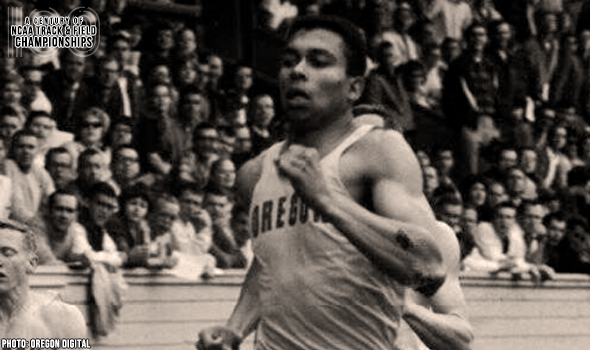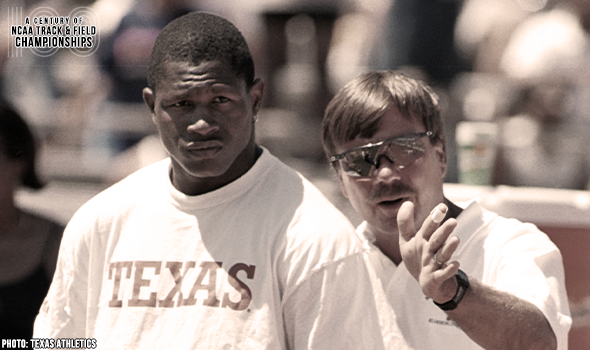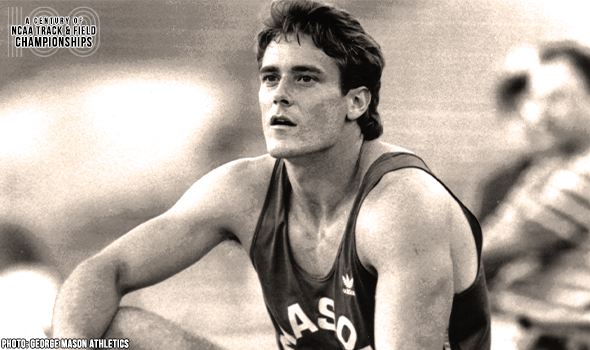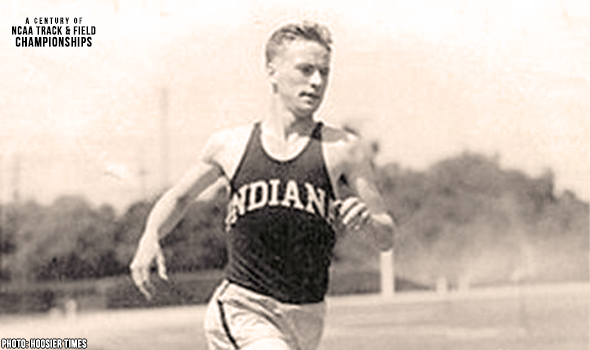
Oregon’s Jerome Sprinted To NCAA Glory
If ever a meet could have used photo-finish timing, it was the 1964 NCAA Outdoor Track & Field Championships.
The 5000 and 400 were both ruled deadlocks, but those were with merely two runners inseparable.
The 100-meter final saw three sprinters crossing the line at almost the same instant: Harry Jerome of Oregon, Edwin Roberts of North Carolina Central and Trenton Jackson of Illinois.
It took almost an hour to sort the finish, but when they did, Jerome was ruled the victor in 10.1. Roberts (second) and Jackson (third) were also credited with that same mark as well.
“Honestly, that’s one I’d hate to judge on,” Jerome said about the finish to Dick Leutzinger of the Eugene Register-Guard. “Usually I know when I win or lose. I’d hate to say on that one.”
While the 10.1 was a meet and collegiate record, it wasn’t a PR for Jerome. He still owned a share of the world record of 10.0 that he set in the summer after his freshman season back in 1960.
Jerome was a Canadian prodigy who came from great lineage. As a high school standout in North Vancouver, British Columbia, he broke a 31-year-old national record in the 220 yards. And many knew his grandfather, John Armstrong Howard, who was the first Black athlete to represent Canada in the Olympic Games.
The fact that Jerome was even running in 1964 – near his best, let alone at all – was a comeback story for the ages. Jerome tore his quadriceps tendon in the fall of 1962 at the British Commonwealth Games and the seriousness of the injury led many to believe that he would never run again. He didn’t believe that and a little over a year later, he opened the 1964 season by equaling the world indoor best in the 60-yard dash with his time of 6.0.
Then at the 1964 NCAA Championships, Jerome doubled back in the 200, taking third to lead Oregon to its second team title in three years – both at Hayward Field. The Ducks won their first national title in 1962 when Jerome won the 220 yards and was runner-up in the 100.
Not long after that, Jerome went to the Tokyo Olympic Games, where he earned his lone Olympic medal – a bronze in the 100.
Jerome died in 1982 of a brain aneurysm at age 42. In 1984, the Labatts Classic held in Burnaby was renamed the Harry Jerome Classic and in 1988 a statue of him was erected in Vancouver’s Stanley Park.
The NCAA and collegiate track & field will mark a momentous milestone in the spring of 2021 -- the 100th anniversary of the NCAA Championships and with that, the NCAA Track & Field Championships. In June 1921, the University of Chicago hosted the first track & field championships in NCAA history.
This point can’t be emphasized enough: Not only was the event the first for NCAA track & field, but the first championships for any sport under the sponsorship of the NCAA.
To celebrate, over each of the next 365 days, the U.S. Track & Field and Cross Country Coaches Association (USTFCCCA) will celebrate moments, student-athletes, and coaches that have made a century’s worth of championships special. From humble beginnings to important historical milestones to the modern-day, collegiate track & field has evolved with the American society.
The 2021 edition of the NCAA Division I Outdoor Track & Field Championships begin with preliminary round action on May 27-29 in Jacksonville, Fla., and College Station, Texas. The championships final site and culmination of the celebration is slated for June 9-12, 2021 at the newly rebuilt Hayward Field in Eugene, Ore.

Spearmon Sprinted Past Stacked 200 Field
Wallace Spearmon Jr. won back-to-back 200m titles at the NCAA DI Outdoor T&F Championships in 2004 & 2005. He ran 19.91 (-0.7 m/s) in 2005 to beat a loaded field by 0.17 seconds.

Collegiate Record For BYU’s Andersen
Kassi Andersen set a collegiate record in the steeplechase of 9:44.95 at the 2003 NCAA DI Outdoor T&F Championships, capping a three-year streak in which BYU athletes won the event.

Hook ‘Em, Ivan: Wagner Tied Best HJ Margin
Ivan Wagner won the high jump at the 1997 NCAA Division I Outdoor T&F Championships by more than four inches to tie the largest margin of victory in meet history.

Mason’s Muzzio Starred In Decathlon
Rob Muzzio won back-to-back decathlon titles at the NCAA DI Outdoor T&F Championships in 1984 & 1985. His victory in 1985 was by 3 points, the smallest margin in meet history.

Roesler Dusted The Competition In 2014
Laura Roesler won the 800 at the 2014 NCAA Division I Outdoor T&F Championships with a negative split (61.06/60.16) & the 2nd largest margin of victory in meet history (1.70 seconds).

Fuchs Went Back-To-Back In Shot Put
Jim Fuchs won back-to-back shot put titles at the NCAA Outdoor Track & Field Championships in 1949 & 1950. He set a meet record in that first year, heaving the orb 17.10m (56-1½).

Lash Led Indiana Dominance In NCAA’s First 5K
Don Lash led a 1-2-4 finish by Indiana in the 5K at the 1936 NCAA Outdoor Track & Field Championships. It was the first time in meet history that one team had three top-4 finishers in that event.

Surprise! Brown’s Win Sent Texas A&M To Title
Kamaria Brown beat Jenna Prandini by 0.007 seconds for the 200-meter title at the 2014 NCAA Division I Outdoor Track & Field Championships. It was the smallest margin of victory in meet history.

Coleman Cruised To The Bowerman In 2017
Christian Coleman dazzled at the 2017 NCAA Division I Outdoor Track & Field Championships and set a collegiate record in the 100!

Blanford Blitzed 100H Record Book
Rhonda Blanford set an all-conditions meet record in the 100 Hurdles of 12.70 at the 1985 NCAA Division I Outdoor T&F Championships. She also won the race by 0.30 seconds!

